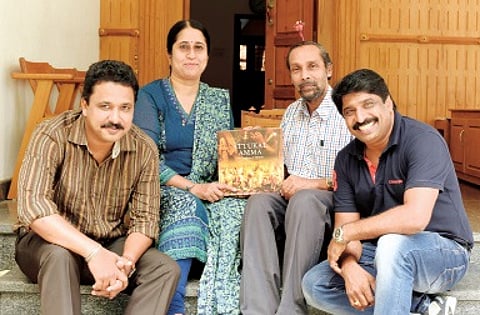

THIRUVANANTHAPURAM: It was four years ago that Lekshmy Rajeev saw the ‘sheeveli’ of Attukal Bhagavathy held close to the chest of a priest. Lost in adoration, the priest was carrying the idol around the temple as part of a ritual. From that moment, she yearned to be like Attukal Amma, whose aura began to overwhelm her psyche. This adoration led to research and meditation the end result of which was the book ‘Attukal Amma, The Goddess of Millions’.
The book authored by Lekshmy, a poet, columnist and translator, unravels the legend about the origin of the Attukal temple and the myth of Kannaki. The literary creation has something for everyone, whether you are a scholar looking to decipher the temple rites, historian trying to trace the evolution of the Bhardakali cult or an ordinary devotee yearning to get a glimpse of the Goddess.
Attukal temple evolved from a Mudippura Lekshmy’s research has unearthed the fact that Aattukaal Temple evolved from a ‘mudippura’ (a humble abode of the deity worshiped by Dalits). Scholars like N Ajith Kumar, B C Balakrishnan and K K Nair, acharya of Khestra Tantra have testified it as a Mudippura. Abhedaananda Swamikal, who laid the foundation stone of the new temple at Aattukaal, too, called it a Mudippura, the book tells us. The intriguing issue whether Aattukaal Amma is Kannaki is also addressed in the book. The link between the Goddess and the Tamil mythical character is considered to be a theory that has been circulated through the media and which later became part of popular imagination. She also examines the processes through which the Mudippura at Aattukaal, turned into a temple where Kshetra Tantra was followed by Brahmin Tantris and priests. The temple, which followed non-brahminical worship later adopted a brahminical mode over the last century and a half.
She points out that the non-brahminical ancient practices such as Thottam Paattu - invoking the Goddess from Kodungallur, Kuthiyottam - were practiced by persons belonging to the backward castes.
“There was not even a single mention of Kannaki in the Thottam pattu. There may be similarities between the myth of Kannaki and Kanyavu. The Bhadrakali cult was prevalent across the state and it was at a later stage that Brahmins incorporated the Kannaki myth with the legend of Attukal amma,” Lekshmy says in the book.
There are chapters on temple rituals, like Sahasrakalasham- Ritual Cleansing of the temple, with rare descriptions of their details.
‘All’s Not Well’ with the temple administration
The book sheds light on the gradual takeover of the temple from the Dalits and Backward communities by a group of Nair families from the locality. In the process, they have even ensured that none of the descendents of judge Govinda Pillai are given a slot in the Trust. It was Pillai who was instrumental in installing the currently worshiped wooden idol of the Goddess in the year 1857.
Obliterating the legacy of Govinda Pillai, the administration of the temple has now fallen into the hands of vested interests. M Bhaskaran Nair, one of the founding trustees of the temple was removed from the post as he had co operated with the author in bringing the facts to light. The author had to face stiff resistance from some of the Trust members as they were scared of facts coming to the fore through the book. Published by Harper Collins Publishers India, the 240 pages book consists of text blended with rare and exquisite photographs.
The pictures have been clicked mostly by Manoj Vasudevan Nair and Hari Thirumala. The illustrations by renowned artist Madanan makes the book a work of art.